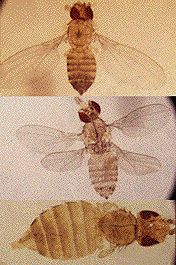Evolutionary developmental biology - How important in evolution are macromutational monsters?

Homeotic mutations
Mutations with effects in early stages of development can have large phenotypic consequences. The homeotic mutations of fruitflies (Drosophila ) are clear examples. The top image is a normal fruitfly but the other two images show fruitflies that have either gained or lost a pair of wings due to a mutation.
Homeotic mutations typically transpose part of the body from one region to another. The mutant bithorax is a well-known case. It has two rear-thoraxes instead of one front and one rear, giving it two pairs of wings instead of a pair of wings and a pair of halteres. Antennapaedia is another example, in which legs grow out of the antennal sockets instead of antennae. At an abstract level, it is easy to imagine how homeotic mutations work. There is presumably a set of genes encoding for the growth of a leg and another set specifying where these leg-genes are switched on. Mutations in the position-specifying genes could result in the genes encoding for leg growth being switched on in the wrong place.
| Next |



